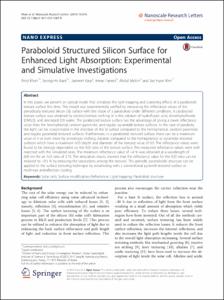Paraboloid Structured Silicon Surface for Enhanced Light Absorption: Experimental and Simulative Investigations
- Title
- Paraboloid Structured Silicon Surface for Enhanced Light Absorption: Experimental and Simulative Investigations
- Author(s)
- Khan, Firoz ; Baek, Seong-Ho ; Kaur, Jasmeet ; Fareed, Imran ; Mobin, Abdul ; Kim, Jae Hyeon
- Issued Date
- 2015-09
- Citation
- Nanoscale Research Letters, v.10, no.1
- Type
- Article
- Author Keywords
- Solar cells ; Surface modification ; Reflectance ; Light trapping ; Paraboloid structure
- Keywords
- Antireflection Coatings ; ANTIREFLECTION LAYER ; Deionized Water ; Electromagnetic Wave Absorption ; Enhanced Light Absorptions ; Fabrication ; High Illumination Conditions ; Hydrofluoric ACID ; INTENSITY ; Light-Trapping ; Light Absorption ; Light Trapping ; MULTICRYSTALLINE SILICON ; Paraboloid Structure ; Photovoltaic Cell Parameters ; Pyramidal Textures ; Reflectance ; Reflectance Values ; Reflection ; Scattering Effects ; Silicon ; Silicon Surfaces ; SOLAR-CELLS ; Solar Cells ; Surface-Texturing ; Surface Modification ; Surface Treatment ; Textured Surface ; TEXTURIZATION
- ISSN
- 1556-276X
- Abstract
- In this paper, we present an optical model that simulates the light trapping and scattering effects of a paraboloid texture surface first time. This model was experimentally verified by measuring the reflectance values of the periodically textured silicon (Si) surface with the shape of a paraboloid under different conditions. A paraboloid texture surface was obtained by electrochemical etching Si in the solution of hydrofluoric acid, dimethylsulfoxide (DMSO), and deionized (DI) water. The paraboloid texture surface has the advantage of giving a lower reflectance value than the hemispherical, random pyramidal, and regular pyramidal texture surfaces. In the case of parabola, the light can be concentrated in the direction of the Si surface compared to the hemispherical, random pyramidal, and regular pyramidal textured surfaces. Furthermore, in a paraboloid textured surface, there can be a maximum value of 4 or even more by anisotropic etching duration compared to the hemispherical or pyramidal textured surfaces which have a maximum h/D (depth and diameter of the texture) value of 0.5. The reflectance values were found to be strongly dependent on the h/D ratio of the texture surface. The measured reflectance values were well matched with the simulated ones. The minimum reflectance value of ~4% was obtained at a wavelength of 600nm for an h/D ratio of 3.75. The simulation results showed that the reflectance value for the h/D ratio can be reduced to ~0.5% by reducing the separations among the textures. This periodic paraboloidal structure can be applied to the surface texturing technique by substituting with a conventional pyramid textured surface or moth-eye antireflection coating. © 2015, Khan et al.
- Publisher
- Springer Verlag
- Related Researcher
-
-
Baek, Seong-Ho
- Research Interests
-
- Files in This Item:
-
 기타 데이터 / 2.76 MB / Adobe PDF
download
기타 데이터 / 2.76 MB / Adobe PDF
download
- Appears in Collections:
- Division of Energy & Environmental Technology 1. Journal Articles



